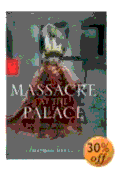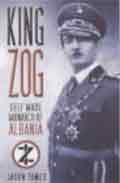Book
Reviews:
The Tragedy of Monarchies
 Jonathan
Gregson, Massacre
at the Palace: The Doomed Royal Dynasty of Nepal (London:
Fourth Estate, 2002).
Jonathan
Gregson, Massacre
at the Palace: The Doomed Royal Dynasty of Nepal (London:
Fourth Estate, 2002).
Jason
Tomes, King Zog: Self-Made Monarch of Albania (Gloucestershire,
UK: Sutton Publishing Limited, 2003).
Reviewed
by Scott B. MacDonald
 Click
here to purchase "Massacre
at the Palace: The Doomed Royal Dynasty of Nepal" directly
from Amazon.com
Click
here to purchase "Massacre
at the Palace: The Doomed Royal Dynasty of Nepal" directly
from Amazon.com
Click
here to purchase "King
Zog: Self-Made Monarch of Albania" directly
from Amazon.com
There
is often an air of tragedy surrounding the history of monarchies.
This is certainly the cases of Albania and Nepal, the subject
of two new books. The first book is by Jason Tomes, King
Zog: Self-Made Monarch of Albania and the second is Jonathan
Gregson's Blood Against the Snows: The Tragic Story of
Nepal's Royal Dynasty. For anyone with an interest in the
hisotry of two countries a bit off the beaten track, Tomes
and Gregson address a gap in the literature, providing
very readable accounts. Tome, a lecturer in modern history
and politics, presents a more traditional history (complete
with footnotes and a bibliography), full of primary sources,
reflecting considerable attention to detail. Gregson's
approach is more journalistic, but benefits from contacts
among the surviving courtiers and members of the Nepalese
royal family. He also has spent a fair amount of his time
with his subject, including being one of the few journalists
to be granted an interview with the late King Birenda.
In both cases, the authors are sympathetic to the countries
and peoples, they are portraying, though neither shrinks
from telling the historical story as they see it.
 Tomes'
King Zog could have easily been titled Everything
That You Want to Know About King Zog. With a well-told
sweap of Albanian/Ottoman/Balkan history, the author
traces the roots of King Zog's family in the Mati
region, the rise of Ahmed Bey Zogolli, first as
a military leader and later as a prime minister,
then president and finally as king. King Zog's
reign lasted from 1928 to 1939, when it was brought
to an end by Benito Mussolini's Fascist legions.
Zog was to leave his country in 1939 never to return.
He eventually died in 1961 in France of cancer
after having lived in exile in London and Egypt
prior. Long years of hoping for a return to power
proved to be futile. Ultimately, King Zog's dreams
came up against the harsh Stalinist reality of
the new communist despot, Enver Hohxa, who was
to rule Albania with an iron fist until his death
in 1986, leaving behind an isolated and amazingly
backward country in the midst of a Europe that
long sionce had bypassed it.
Tomes'
King Zog could have easily been titled Everything
That You Want to Know About King Zog. With a well-told
sweap of Albanian/Ottoman/Balkan history, the author
traces the roots of King Zog's family in the Mati
region, the rise of Ahmed Bey Zogolli, first as
a military leader and later as a prime minister,
then president and finally as king. King Zog's
reign lasted from 1928 to 1939, when it was brought
to an end by Benito Mussolini's Fascist legions.
Zog was to leave his country in 1939 never to return.
He eventually died in 1961 in France of cancer
after having lived in exile in London and Egypt
prior. Long years of hoping for a return to power
proved to be futile. Ultimately, King Zog's dreams
came up against the harsh Stalinist reality of
the new communist despot, Enver Hohxa, who was
to rule Albania with an iron fist until his death
in 1986, leaving behind an isolated and amazingly
backward country in the midst of a Europe that
long sionce had bypassed it.
Where then did all this leave King Zog in the great flow of history? Tomes
asks the question of Albania's one and only king: "Adventurer or patriot?
Hero or scroundrel?" On the scroundrel side, he reagrds Zog as a self-made
monarch, shifting from being president to king with relative ease, willing
and able to eliminate or buy off/exile any opposition, channel what revenues
the state generated into his own coffers, and being dependent on Italian
assistance (much of went into his own pockets). Indeed, he notes other
writers "detect nothing worthy of praise and dismiss the appalling
Zog as an unsavory tyrant." He adds: His personal wealth sham elections
and political murder feature prominently here."
Yet, Tomes contends Zog came to power over a backward, tribal-like society,
riven by regional and religious differences. In addition, Albania's neighbors
were not thrilled with the birth of th> e new country, considering that
Yugoslavia, Italy and Greece all held territorial claims and/or overlapping
populations. Indeed, Albania was a small, poor nation caught up in the
power politics of a Europe heading into the Second World War, a situation
which left her with few international friends and at the mercy of Italy,
already the mainstay of the economy in terms of massive amounts of foreign
loans. Consequently, Tomes makes the point that before Zog Albania largely
existed as an idea, but central authority was weak and in many parts of
the country, nonexistant. In two decades, Zog managed to consolidate the
Albanian state and provide a more enduring foundation for the country's
future as a nation-state with respected international borders. Tomes concludes
his masterful treatment of King Zog with the following assessment:
Soon Albanians will be able to look dispassionately at their history in
the twentieth century: liberation, instability, occupation, instability,
Zogist dictatorship, occupation, civil war, Stalinist dictatorship, and
more instability. When they do, they may will count the reign of King Zog
among the good times. It is a sobering thought.
At the other end of the Eurasian landmass, the trials and tribulations
of the Nepalese royal family represented a very different historical track
record in terms of longevity of royal rule, but smilar in terms of a small,
relatively backward nation, sorrounded by larger more powerful neighbors
(China and India). Like Albania, Nepal was a very tribal surrounded, divided
by tough mountainous terrain. It was in this environment that the Shah
dynasty came to power over a united Nepal in 1769. That same dynasty was
almost snuffed out of existance in June 2001, when the Crown Prince Dipendra
shot and killed most of his immediate family, including his father, King
Birendra and his mother, the Queen. Armed with a 9 mm Glock pistol, MP5K
sub-machine gun, Colt M-16 and Franchi twelve-bore pump action shot gun,
the Crown Prince ultimately killed 12 members of the royal family in a
cold-blooded and methodical fashion and then turned the gun on himself,
only to linger a couple of days before succumbing to his wounds. In a hastily-organized
cornation, Prince Gyanendra, a brother of the deseased King, became the
new king, a strange twist of fate considering that he had at the age of
three been crowned monarch, serving a brief three month period in 1950
before a popular coup ousted the then overly powerful prime minister.
The immediate cause of the 2001 palace masssacre was a bitter conflict
between Queen Aishwarya and the Crown Prince over whom he would marry.
Indeed, the Queen was known for her unbending will and for being unable
to bear any snubs, especially from any commoners. The Crown Prince's preference,
Devyani, was the daughter of a weathly and well-placed Indian family. The
Queen, however, was anti-Indian, having earlier gotten herself embroiled
in a tiff with the Gandhi family. In addition, Gregson also believes that
the Queen "would not tolerate a woman as independent and tough-minded
as Devyanyi becoming her daughter-in-law." Consequently, the Queen
did everything possible to ruin the relationship between her son and the
woman he loved. Adding to what was to be a volatile mix, the Crown Prince
was prone to mood swings and used drugs. On the night of June 1st, the
Crown Prince apparently decided that he had taken enough from his parents,
feeling a strong sense of betrayal from his father and deeply resentful
of his mother.
Although much attention is given to the events leading up to the June 2001
palace massacre, Gregson does an excellent job in telling the story in
the context to Nepal's dynastic history, especially since the Shah family
cam> e to power in the 18th century. In large part, he notes that the
role of the royal family at the apex of Nepal's political culture and society
played an important role in setting the sateg for the June 2001 bloodshed.
The royal family had long ruled, often through absolutist prime ministers,
apart from the rest of Nepalese society - the vast majority of whom were
poor, yet reverent of the king. In this regard, politics in Nepal were
limited to a handful of royal families and the families of the prime ministers.
Signiciantly, differences of opinion were often settled by violence. As
Nepal advanced into the 20th century, there developed a gap between the
relatively isolated royal family (living a rich lifestyle behind the walls
of their many palaces) and the vast majority of Nepalese. The 1990 pro-democracy
riots cut into the royal family's base of power, but the lifestyle of privilage
continued unabated. In this light, the unbending nature of Queen Aishwarya > is
portrayed as a lynchpin in undermining the Shah dynasty as it was opposition
to the Crown Prince's love and triumpal nature caused the Crown Prince
to resolve matters in what manner such affairs had been resolved in the
past - violence.
Nepal was left "bereft and confused" by the palace massacre and
the new king sits uneasy on the throne. Covering a third of the country,
a Maoist insurrection challenges the royal government, grappling to respond.
Blood Against the Snows provides a useful reference point to the ills that
are confronting Nepal, a country that is usually beyond the general media
scope. Although the Maoist insurrection is not discussed in any detail,
Gregson does provide insight into part of the country's ruling elite -
a partial cuase for the insurrection. It is little wonder that the end
of the monarchy is one of the major objectives of the Maoists. Blood Against
the Snows is highly recommended.






 Tomes'
King Zog could have easily been titled Everything
That You Want to Know About King Zog. With a well-told
sweap of Albanian/Ottoman/Balkan history, the author
traces the roots of King Zog's family in the Mati
region, the rise of Ahmed Bey Zogolli, first as
a military leader and later as a prime minister,
then president and finally as king. King Zog's
reign lasted from 1928 to 1939, when it was brought
to an end by Benito Mussolini's Fascist legions.
Zog was to leave his country in 1939 never to return.
He eventually died in 1961 in France of cancer
after having lived in exile in London and Egypt
prior. Long years of hoping for a return to power
proved to be futile. Ultimately, King Zog's dreams
came up against the harsh Stalinist reality of
the new communist despot, Enver Hohxa, who was
to rule Albania with an iron fist until his death
in 1986, leaving behind an isolated and amazingly
backward country in the midst of a Europe that
long sionce had bypassed it.
Tomes'
King Zog could have easily been titled Everything
That You Want to Know About King Zog. With a well-told
sweap of Albanian/Ottoman/Balkan history, the author
traces the roots of King Zog's family in the Mati
region, the rise of Ahmed Bey Zogolli, first as
a military leader and later as a prime minister,
then president and finally as king. King Zog's
reign lasted from 1928 to 1939, when it was brought
to an end by Benito Mussolini's Fascist legions.
Zog was to leave his country in 1939 never to return.
He eventually died in 1961 in France of cancer
after having lived in exile in London and Egypt
prior. Long years of hoping for a return to power
proved to be futile. Ultimately, King Zog's dreams
came up against the harsh Stalinist reality of
the new communist despot, Enver Hohxa, who was
to rule Albania with an iron fist until his death
in 1986, leaving behind an isolated and amazingly
backward country in the midst of a Europe that
long sionce had bypassed it.